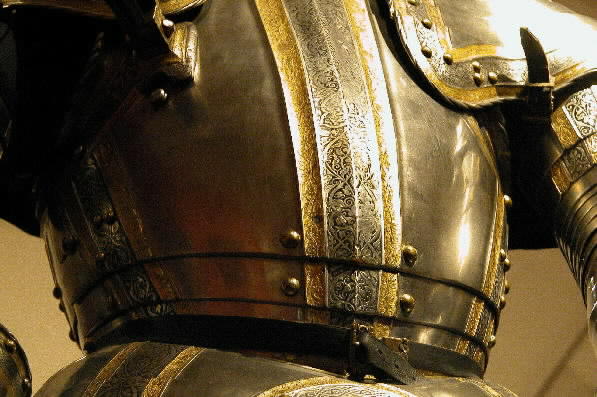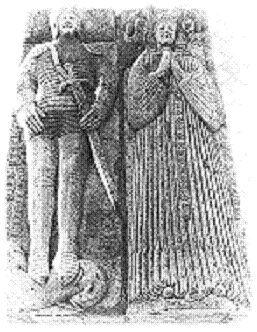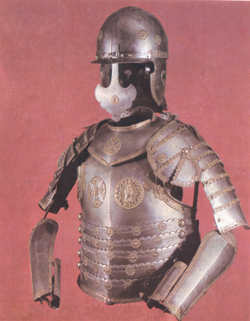Most images of 16th century harness that I have seen use the peascod cuirass, or some variation of this.
My question is, would two-piece breatplates still have been in use at this time? It seems like the two-piece was a natural evolution that provided more mobility (As anyone who has ever worn a breastplate can surely attest). Why would they have gone away from this in the 16th?
I'm not certain about two-piece breastplates in particular, but multi-piece breastplates were certainly popular. There is a woodcut of Henri II of France from about 1550 wearing one of these (and it's still in existence as well, though not quite as nicely gilded as it once was), and there are also examples of cuirasses in England and other parts of Europe that were similarly constructed, like this one:
[ Linked Image ]
This fashion in fact lasted well into the 17th Century among the Poles, which is interesting to note.
So there was still a desire for some movement within the confines of the steel through it's articulation, but as far as I know of, not with the simple two-piece cuirasses of the 15th Century. However, I'd love to see some examples!
Cheers!
Gordon
[ Linked Image ]
This fashion in fact lasted well into the 17th Century among the Poles, which is interesting to note.
So there was still a desire for some movement within the confines of the steel through it's articulation, but as far as I know of, not with the simple two-piece cuirasses of the 15th Century. However, I'd love to see some examples!
Cheers!
Gordon
I've never seen a 16th century dated 2 piece breastplate anywhere in the UK. Certainly I've seen the odd looking lamed things but never a style similar to the 15th Century 2 piece. I suspect it's due to the increasingly dangerous performance of firearms, coupled with the cost of increasingly larger armies. I could be wrong but that what I think!
many of the 15th century breastplates are fixed by rivets making them in effect one solid breastplate. A good one piece breastplate should not limit you much if at all. I think it just made things easier and in the case of solid ones served little purpose as the same could be done with one piece. The double layering may have been to thicken specific areas more and in the 16th it was just done to the entire piece as the need for thicker armour due to better firearms.
RPM
RPM
There are a good number of backplates of mid to late 15th century date in the collection of armour from the fortress of Rhodes that are made in three parts, a central plate and two side plates that wrap around rivted to them that would have gone with the large number of plackards ( in this case the lower halves of two piece breast plates rather than stand alone plates) from the same armour collection and of the same window of manufacture, so ease of manufacture may very well have been at least part of the reason. We've used the three piece back plate before and is is much easier to construct that from one piece of steel. Of note is that these pieces some of them 50 and 60 years old at the time of the fall of the fortress (1522 AD) were still in service at that time.
A peascod shape with one or more waist lames was not uncommon, especially in the Holy Roman Empire. They allow for a sleeker shape than the classic one piece, which requires that the lower it goes, the further it has to be from the body to allow forward bending.
 Attachment: 52.19 KB
Attachment: 52.19 KB


Hello all!
Yes, there were laminated breast plates used in the sixteenth century, often of Italian manufacture. These types of breast plate are given the name anime. George Cameron Stone, in his glossary of arms and armor, claimed that the overlapping of the joints of the lames upward made it a poor defence. This work showed a possible Venetian example of an anime of the second half of the sixteenth century with embossed decoration on the uppermost lame that is (or was) in the Metropolitan Museum of Art.
There is an informative definition of anime in The Complete Encyclopedia of Arms & Weapons, edited by Leonid Tarrasuk and Claude Blair. Here's the entry:
There is an interesting example of an anime cuirass in An Historical Guide to Arms & Armor by Stephen Bull. It is actually something of a cross between an anime and the cuirass with the waist lames that James posted. The one in Bull's book is Milanese, from circa 1600. It has five lames on the lower end of the torso. The upper part is a breastplate decorated with a depiction of the Virgin and Child, flanked by St. Jerome and St. Christopher. The caption claims that the lames may have come from a separate armour that was matched with the solid breast. This is in the Wallace collection.
Anime armours are also shown in the colour plates in the Osprey book The Irish Wars 1485-1603 by Ian Heath. These armours are shown worn by the Anglo-Irish Earl of Ormond, circa 1539, and and Anglo-Irish man-at-arms of circa 1552. The caption to the plate claims the illustrations are inspired by surviving monumental effigies in the Dublin Pale. However, I'm not sure how accurate their reconstructions are in this particular volume.
Does anyone have any more information, or better yet images, of Anglo-Irish armour of the sixteenth century? Did they indeed wear a style of armour that included an anime cuirass? I would appreciate any further information regarding this issue.
Thanks!
Stay safe!
By the way, below is an image I found on-line of the effigy of Piers Butler, Earl of Ormond, and his wife. It does appear as if he wears an anime cuirass with fairly narrow lames. So maybe that particular reconstruction isn't too far off the mark. (Sorry for the poor quality, it was rather small, and I enlarged it.)
 Attachment: 33.7 KB
Attachment: 33.7 KB

The tomb of Piers and Margaret Butler in Kilkenny.
Yes, there were laminated breast plates used in the sixteenth century, often of Italian manufacture. These types of breast plate are given the name anime. George Cameron Stone, in his glossary of arms and armor, claimed that the overlapping of the joints of the lames upward made it a poor defence. This work showed a possible Venetian example of an anime of the second half of the sixteenth century with embossed decoration on the uppermost lame that is (or was) in the Metropolitan Museum of Art.
There is an informative definition of anime in The Complete Encyclopedia of Arms & Weapons, edited by Leonid Tarrasuk and Claude Blair. Here's the entry:
| Quote: |
|
anime A type of laminated cuirass introduced in the second quarter of the 16th century and probably first designed in Italy. It was built up of horizontal overlapping lames connected by sliding rivtes and leather straps. This form went out of fashion in western Europe at the end of the 16th century but remained in wide use throughout the next century in eastern European countries, particularly Hungary and Poland, where it was part of the heavy-cavalry armor (Hussar armor). |
There is an interesting example of an anime cuirass in An Historical Guide to Arms & Armor by Stephen Bull. It is actually something of a cross between an anime and the cuirass with the waist lames that James posted. The one in Bull's book is Milanese, from circa 1600. It has five lames on the lower end of the torso. The upper part is a breastplate decorated with a depiction of the Virgin and Child, flanked by St. Jerome and St. Christopher. The caption claims that the lames may have come from a separate armour that was matched with the solid breast. This is in the Wallace collection.
Anime armours are also shown in the colour plates in the Osprey book The Irish Wars 1485-1603 by Ian Heath. These armours are shown worn by the Anglo-Irish Earl of Ormond, circa 1539, and and Anglo-Irish man-at-arms of circa 1552. The caption to the plate claims the illustrations are inspired by surviving monumental effigies in the Dublin Pale. However, I'm not sure how accurate their reconstructions are in this particular volume.
Does anyone have any more information, or better yet images, of Anglo-Irish armour of the sixteenth century? Did they indeed wear a style of armour that included an anime cuirass? I would appreciate any further information regarding this issue.
Thanks!
Stay safe!
By the way, below is an image I found on-line of the effigy of Piers Butler, Earl of Ormond, and his wife. It does appear as if he wears an anime cuirass with fairly narrow lames. So maybe that particular reconstruction isn't too far off the mark. (Sorry for the poor quality, it was rather small, and I enlarged it.)

The tomb of Piers and Margaret Butler in Kilkenny.
I forgot the rather odd and faishonable Waistcoat armour. There are a number of peascod breastplates that open along the middle of the front. Odd but rather nice to see. These are normally made in five plates. Three for the back and two for the front, all hinged. I suspect these would be rather more flexible than 2 rigid plates.
By Anglo Irish, what do you mean? New English, Old English or Irish. By this I mean the new wave of settlers and projectors, all protesant. Or Old English, or Irish, all mostly Catholic.
If New English, then it's all the latest trends. If Old English it could be the latest trends, or Irish styles. If Irish it could be imported Spanish style for some and mostly Irish styles! That should prove confusing!
Sorry. Forgot this link...
http://www.lib.ed.ac.uk/about/bgallery/Galler...eland.html
A little overstated but fairly close!
By Anglo Irish, what do you mean? New English, Old English or Irish. By this I mean the new wave of settlers and projectors, all protesant. Or Old English, or Irish, all mostly Catholic.
If New English, then it's all the latest trends. If Old English it could be the latest trends, or Irish styles. If Irish it could be imported Spanish style for some and mostly Irish styles! That should prove confusing!
Sorry. Forgot this link...
http://www.lib.ed.ac.uk/about/bgallery/Galler...eland.html
A little overstated but fairly close!
| David Evans wrote: |
| By Anglo Irish, what do you mean? New English, Old English or Irish. By this I mean the new wave of settlers and projectors, all protesant. Or Old English, or Irish, all mostly Catholic.
If New English, then it's all the latest trends. If Old English it could be the latest trends, or Irish styles. If Irish it could be imported Spanish style for some and mostly Irish styles! That should prove confusing! |
David,
Sorry for being rather vague, Ireland in the sixteenth century isn't really my main period of interest, but I'm always fascinated by the odd and different. I felt that the possible anime cuirass on the Anglo-Irish effigies was a bit different. I was wondering specifically about lords like Piers Butler, Earl of Ormond, and men-at-arms of the same ilk. I really don't know enough about the history of the time to place him as "New English", "Old English", or "Irish". The caption in the Osprey book stated that the armour was a bit archaic, especially on the man-at-arms in the same plate. I wonder if this means that they are "Old English". Would this mean that they would adopt a lighter style of armour as was possibly popular amongst the Irish? I'm always leery about relying on information in the Osprey books; I like to have other sources to back it up before I accept it as reliable. The photo of the effigy of Piers Butler that I found suggests that the colour plate wasn't too far off the mark, at least for that particular figure.
Thanks for the link. I've seen a few of these images before, but it's nice to see larger versions.
Stay safe!
In the RA, William Herberts armour has two bottom lames on the breast plate from c. 1550ish. Perhaps helpful?
RPM
RPM
Hello all!
I found an image of a Hussar's armour from circa 1630. This example is an anime with a fairly large solid upper plate. It's an example of this form used into the 17th century in Eastern Europe. I know this is straying off-topic a bit, but I thought I would share what I found.
Stay safe!
 Attachment: 9.95 KB
Attachment: 9.95 KB

Hussar armour, 1630.
I found an image of a Hussar's armour from circa 1630. This example is an anime with a fairly large solid upper plate. It's an example of this form used into the 17th century in Eastern Europe. I know this is straying off-topic a bit, but I thought I would share what I found.
Stay safe!

Hussar armour, 1630.
In the Royal Armouries publication on London Armourers there are references to two similar features. It seems that there was a trend to work a second plate into armour inteneded for Horse, to thicken it and thereby improve it's resistance to shot, this appears to have been carried on into the reign of Charles II with reinforcing plates been made to wear over the breastplate on Horse armour, these plates being known as plackets
Page 1 of 1
You cannot post new topics in this forumYou cannot reply to topics in this forum
You cannot edit your posts in this forum
You cannot delete your posts in this forum
You cannot vote in polls in this forum
You cannot attach files in this forum
You can download files in this forum
All contents © Copyright 2003-2006 myArmoury.com — All rights reserved
Discussion forums powered by phpBB © The phpBB Group
Switch to the Full-featured Version of the forum
Discussion forums powered by phpBB © The phpBB Group
Switch to the Full-featured Version of the forum